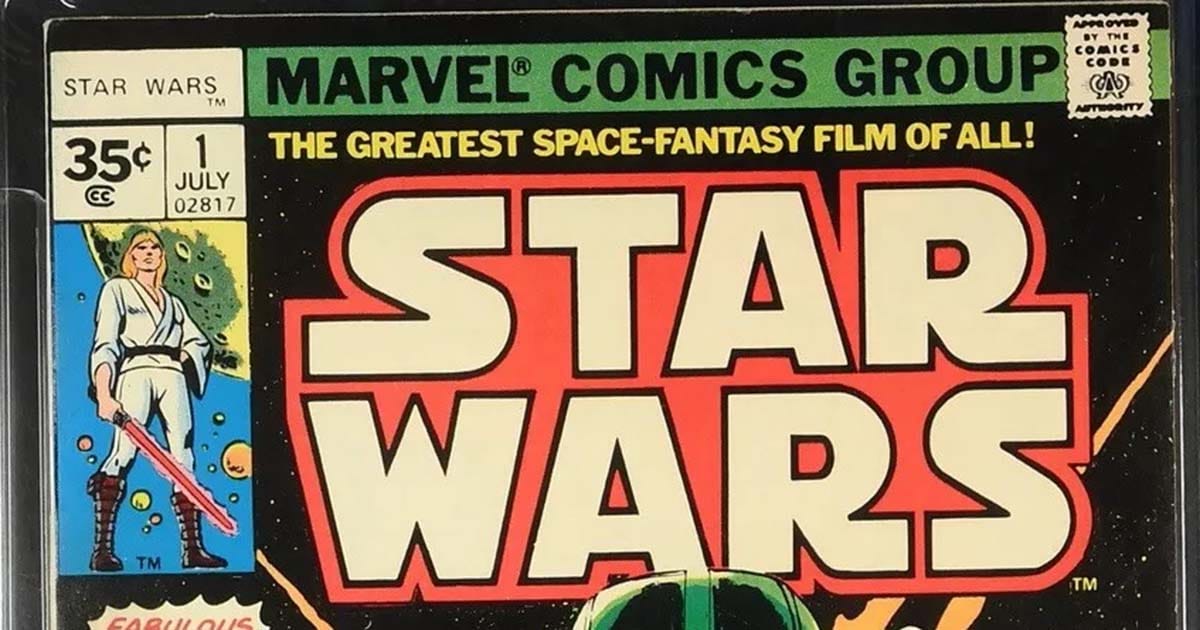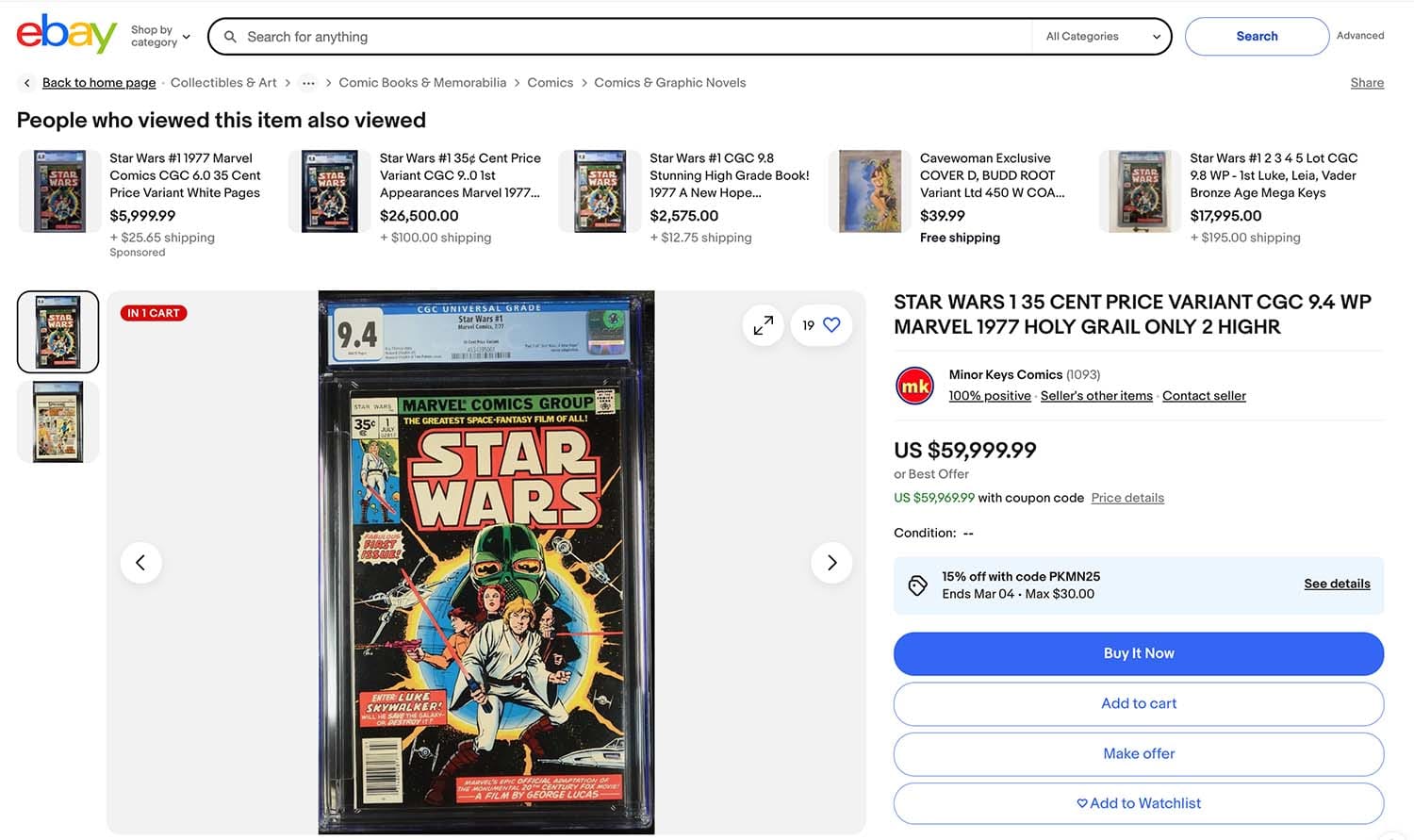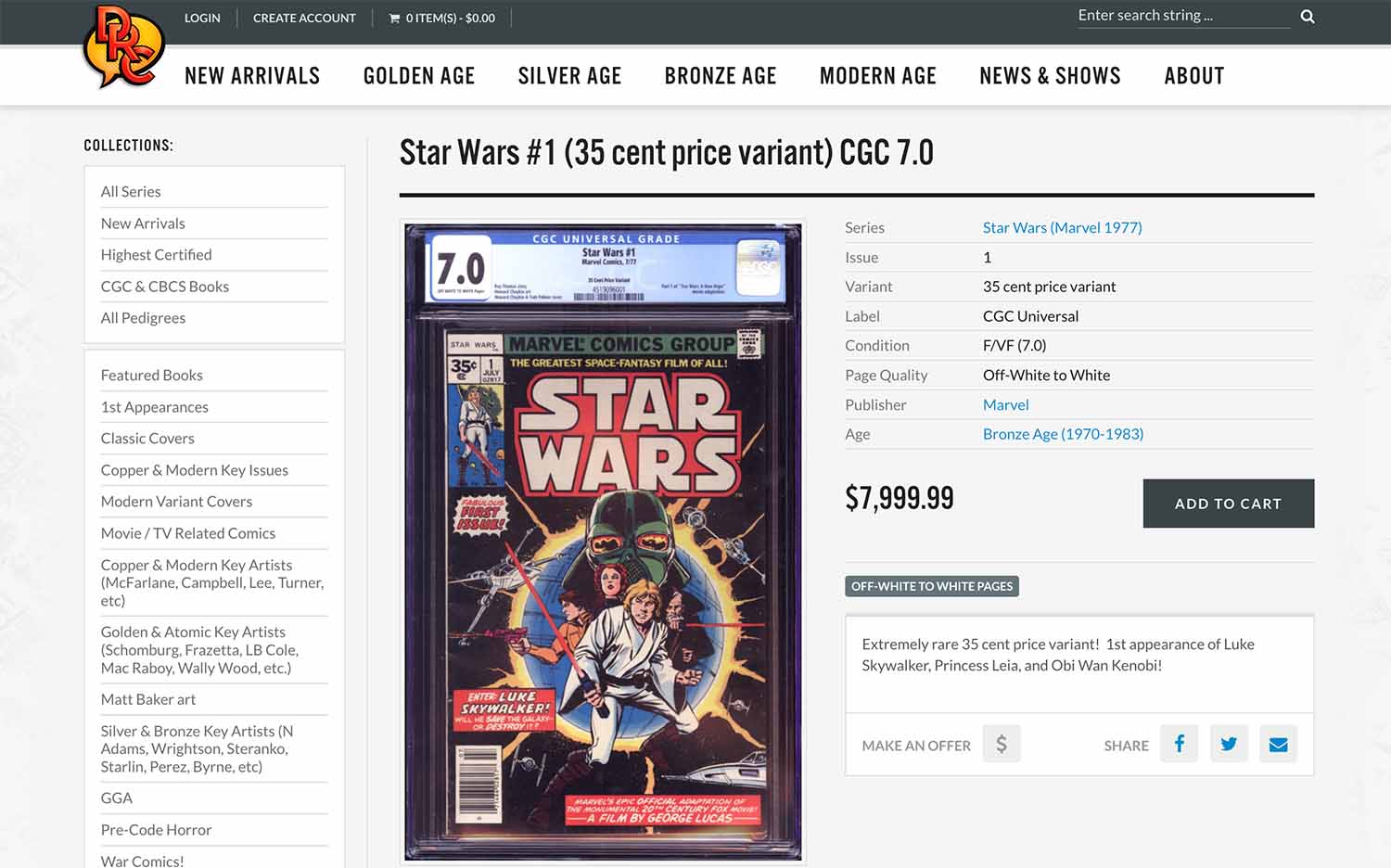"Star Wars" #1, 35-cent Price Variant
An exploration of the rare 35-cent variant of 'Star Wars #1' from 1977, highlighting Marvel’s experiment, the comic’s cult status, and essential tips for verifying authenticity. Great for collectors.

In 1977, theater lines wrapped around blocks as audiences flocked to see the groundbreaking space adventure, "Star Wars." The film's instant success had a ripple effect that reached far beyond movie screens.
Over at Marvel Comics, the decision to adapt "Star Wars" into a monthly series came at a critical moment. Facing financial strain, the company saw this new title as a potential lifeline.
Readers responded with overwhelming enthusiasm, sending sales figures soaring and helping Marvel regain a foothold in a tough market.
Out of this frenzy emerged the now-famous 35-cent price variant of "Star Wars #1." Although it might seem like a small difference in cover price (compared to the 30-cent standard price), that higher cost and limited distribution turned the issue into a bona fide collectible legend.
Marvel Comics and the 1970s Landscape
By the mid-1970s, the comic book marketplace was in a state of flux. Newsstand sales were declining as retail spaces shifted priorities, leaving publishers eager to find creative ways to boost revenue.
Marvel Comics explored several methods, including experimenting with higher cover prices in specific regions to see if readers would pay the extra nickel. These test runs were not entirely uncommon; still, they represented a calculated gamble in an era when many households were counting every penny.
Amid this unsettled environment, Marvel secured the license to produce a comic based on "Star Wars." The timing could not have been better. Fans of the film were hungry for more stories set in George Lucas's galaxy, making "Star Wars #1" a vital new addition to Marvel's roster.
The Creation of the 35-Cent Variant
When Marvel decided to increase the cover price of "Star Wars #1" from 30 cents to 35 cents, it was not done with universal fanfare. Instead, the company quietly shipped a limited number of these higher-priced copies to select areas. This strategy was simple on paper. If comic enthusiasts in certain cities continued buying at 35 cents, Marvel might roll out the increase nationwide.
Precisely which locales received the 35-cent version remains somewhat mysterious. Collectors often cite four to six U.S. test markets—places like Memphis, Toledo, and Tuscaloosa—but the exact distribution footprint has never been definitively confirmed.
Over the years, the scarcity of these issues gave rise to countless rumors, with some speculating only a few thousand copies were ever printed —1,500 is perhaps the most common number given.
The result was a perfect storm of low supply and high demand. Once fans realized just how limited the 35-cent variant was, it became a prized trophy in Bronze Age comic collecting.
Today, these rare copies command stratospheric prices, placing them squarely among the era's most sought-after treasures. In February 2025, for example, Minor Key Comics was asking $59,999.99 for its CGC-graded 9.4 copy of the comic. A CGC 7.0 version of the 35-cent variant had an asking price of $7,999.99.

Identifying the 35-Cent Variant
For collectors on the hunt, spotting a legitimate 35-cent copy of "Star Wars #1" boils down to a few key details. First, check the cover's upper left corner: a genuine 35-cent copy displays a square price box that reads "35¢" alongside the Marvel Comics banner. You should also see "July" printed beneath the issue number. Because most of these higher-priced copies were sold at newsstands, many still feature a standard barcode at the bottom left, rather than a blank or specialty box.
35-Cent Variant (First Printing)
| Characteristic | Details |
|---|---|
| Price Box | Square price box in the upper left corner of the cover |
| Issue Number | The word "July" is printed beneath the issue number |
| Barcode | Features a barcode in the UPC box at the bottom left of the cover |
30-Cent Variant (First Printing)
| Characteristic | Details |
|---|---|
| Price Box | Diamond-shaped price box in the upper left corner of the cover |
| Issue Number | Does not include "July" beneath the issue number |
| Barcode | Has a blank UPC box instead of a barcode at the bottom left of cover |
Be wary of reprints that can muddy the waters. Whitman editions, for instance, usually show a diamond-shaped price box, and some may include "REPRINT" on the cover. While a 35-cent figure might appear there, it often signals a later printing rather than the scarce first-run variant.
| Variant | Key Features | Typical Market Value | Additional Notes |
|---|---|---|---|
| 35-cent price variant | - Square price box reads “35¢” - “July” under issue number - Standard barcode (newsstand) |
Very high in all grades | Considered a test market copy. Estimates suggest around 1,500–2,000 printed. Among the most sought-after Bronze Age comics. |
| 30-cent price variant | - Square price box reads “30¢” - “July” under issue number - Standard barcode (newsstand) |
Moderately high, especially in high grade | The standard first printing. Much larger print run than the 35-cent version but still collectible. |
| 30-cent Whitman edition | - Diamond-shaped price box - Often sold in 3-packs - Typically found without a barcode |
Generally lower than the standard version | A reprint of the original comic. Commonly identified by the diamond price box and often missing the word “July.” |
| 35-cent Whitman edition | - Diamond-shaped price box reads “35¢” - Reprint distribution through non-traditional channels |
Less valuable than true 35-cent variant | Similar to the 30-cent Whitman edition, but with a 35-cent cover price. Not part of the official test market print run. |
| 35-cent reprint with a diamond-shaped price box | - Reprint edition showing “35¢” - Lacks a barcode - Diamond-shaped price box |
Lower-tier value compared to original variant | Often confused with the authentic 35-cent test market issue. Print details differ from the first printing (e.g., cover date layouts, paper stock). |
| Reprint of "Star Wars #1" (1977) | - Usually stamped “REPRINT” in the upper left corner - May show a different price box shape or configuration |
Minimal compared to first printing | Clearly labeled “REPRINT.” Distributed well after the original run. |
| Canadian edition with a $1.50 cover price | - Printed for Canadian markets - Significantly higher cover price - Often has unique distribution markings |
Collectible but not typically as high-valued | Released at different times for Canadian newsstands. Not to be confused with the U.S. 35-cent variant. |
Counterfeits are another concern. Unscrupulous sellers have been known to alter the original 30-cent box to read 35 cents, or to cut and paste numbers in ways that appear suspiciously off-color or misaligned. Before purchasing, compare the book's font, ink consistency, and spacing with known authentic examples to avoid a counterfeit disappointment.

An Extra Nickel
The elusive 35-cent variant of "Star Wars #1" stands at a fascinating intersection of comic history and the ongoing appeal of George Lucas's space opera. Its rarity, combined with a compelling backstory, has made it an enduring topic of conversation among collectors. In many ways, it represents Marvel's bold willingness to experiment during a difficult time and the unwavering passion fans hold for all things "Star Wars." For those who manage to secure a copy, it is a prized piece of pop culture lore.

